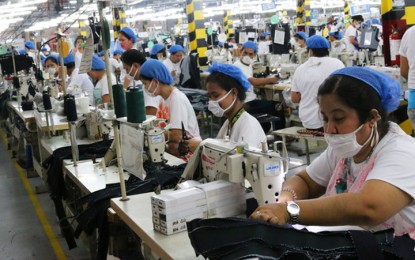[5.8] 3월 필리핀 실업자 수 감소
컨텐츠 정보
- 18,748 조회
본문
마닐라 – 필리핀 통계청(PSA)은 월요일에 필리핀 실업률이 2월 4.8%에서 3월 4.7%로 하락했다고 발표했습니다.
기자 회견에서 PSA 차관 겸 국가 통계학자인 "Dennis Mapa"는 최신 노동력 조사(LFS)의 예비 결과에 따르면 2023년 3월 노동력에 있었던 5100만 명의 필리핀인 중 242만 명의 실직 필리핀인이 감소한 것으로 나타났습니다. .
한편 경제활동참가율은 2월 66.6%에서 66%로 떨어졌다.
3월 취업률은 95.3%로 전월(95.2%)보다 높아졌다.
"마파"는 고용이 가장 많이 증가한 산업은 운송 및 보관, 숙박 및 요식업, 도소매업, 건설 및 기타 서비스업이라고 말했습니다.
산업군별로는 서비스 부문이 2023년 3월 전체 고용 인구의 59%를 차지하며 계속해서 최고의 고용 허브가 되고 있습니다.
그 뒤를 이어 농업과 산업 분야가 각각 전체 취업자의 23.5%와 17.5%를 차지했다.
불완전 고용률은 2월 12.9%에서 11.2%로 안정되어 2005년 4월 이후 가장 낮았습니다.
재무부(DOF)는 성명에서 최신 고용 데이터를 보면 베트남이 노동 시장에서 지속적으로 개선되고 있음을 알 수 있다고 말했습니다.
DOF 장관 "Benjamin Diokno"는 낮은 실업률과 고용 수치 개선은 "우리 경제가 지속적인 회복과 성장을 위한 준비가 되어 있음을 나타냅니다."라고 말했습니다.
Diokno는 "주로 경제 자유화법과 필리핀에서의 사업 용이성 향상을 통해 외국인 직접 투자를 유치하려는 정부의 추진력은 중기적으로 일자리와 사업 기회를 창출할 것으로 기대된다"고 말했다.
한편, 국가경제개발청(NEDA)은 정부가 필리핀 근로자를 위한 양질의 일자리를 창출하기 위해 노동 생산성을 계속 높이고 투자를 추진할 것이라고 다짐했습니다.
NEDA 장관 "Arsenio Balisacan"은 정부가 현재 노동 생산성과 고품질 일자리 창출을 개선하기 위해 문제와 제약을 해결하고 있다고 말했습니다.
“주요 경제 자유화 개혁을 통과시키는 것은 중요한 첫 단계입니다. 그러나 이웃 국가들 역시 공격적으로 투자 경쟁을 벌이고 있는 지역에서 우리는 사업의 용이성과 관련된 현장 문제를 시급히 해결함으로써 이러한 국가 정책 체제의 변화를 활용해야 합니다." 별도의 진술.
"투자자들을 기다리게 해서는 안 됩니다. 우리는 그들이 상점을 쉽게 설립하고, 확장하고, 우리가 필요로 하는 양질의 일자리를 창출할 수 있도록 하는 규제 환경을 조성해야 합니다."라고 그는 덧붙였습니다.
정부가 인프라 추진을 추구함에 따라 "Balisacan"은 물리적 자본에 대한 투자로 인한 생산성 향상을 보완하기 위해 인적 자본의 상당하고 지속적인 개선이 필요할 것이라고 말했습니다.
“국가의 건강, 영양 및 교육 관련 결과를 개선하는 것은 동남아시아 이웃 국가에 비해 국가 노동력의 경쟁력을 유지하는 데 핵심이 될 것입니다. 인적 자본에 대한 투자는 증가하는 노동 연령 인구가 일자리, 시장 및 기술 기회를 극대화할 수 있도록 하고 국가가 인구 배당금의 혜택을 거둘 수 있도록 할 것입니다."라고 그는 말했습니다.
NEDA 책임자는 또한 정부 기관, 교육 기관, 기술 제공자 및 기타 이해 관계자 간의 협력이 디지털 기술 및 혁신에 대한 기술 향상 및 재교육을 위한 새로운 기술을 탐색하고 활용하는 것이 중요하다고 언급했습니다.
“규제 개혁, 인적 자본에 대한 전략적 투자, 번성하는 혁신 생태계 – 이것들은 우리가 전반적인 복지를 높이고 환경 변화를 충족시키기 위해 노력할 때 노동 시장에서 볼 수 있는 이익을 지속할 수 있게 해주는 절실히 필요한 요소 중 일부입니다. 용어 사회 경제적 목표”라고 "Balisacan"이 추가되었습니다. (PNA)
This is the Original Artcl from PNA NEWS
[5.8] Number of jobless Filipinos down in March
MANILA – The country's unemployment rate went down to 4.7 percent in March from 4.8 percent in February, the Philippine Statistics Authority (PSA) reported on Monday.
In a press conference, PSA Undersecretary and National Statistician "Dennis Mapa" said preliminary results of the latest Labor Force Survey (LFS) showed the decline translates to 2.42 million unemployed Filipinos, out of 51 million Filipinos who were in the labor force in March 2023.
Labor force participation rate, meanwhile, fell to 66 percent from 66.6 percent in February.
Employment rate in March was estimated at 95.3 percent, up from the 95.2 percent the previous month.
"Mapa" said industries with largest increase in employment include transportation and storage, accommodation and food service activities, wholesale and retail trade, construction and other service activities.
By industry group, the services sector continued to be the top employment hub, with a share of 59 percent of the total employed population in March 2023.
It was followed by the agriculture and industry sectors which accounted for 23.5 percent and 17.5 percent of the total employed persons, respectively.
Underemployment rate, which settled at 11.2 percent from 12.9 percent in February, was the lowest reported since April 2005.
In a statement, the Department of Finance (DOF) said the latest employment data shows that the country is seeing continued improvements in the labor market.
DOF Secretary "Benjamin Diokno" said the lower unemployment rate and improvement in employment figures "indicate that our economy is poised for continued recovery and growth."
“The government’s drive to attract foreign direct investments, mainly through the economic liberalization laws and efforts to enhance the ease of doing business in the Philippines, are expected to generate jobs and business opportunities in the medium term,” "Diokno" said.
Meanwhile, the National Economic and Development Authority (NEDA) vowed that the government will continue to enhance labor productivity and push for investments to generate high-quality jobs for Filipino workers.
NEDA Secretary "Arsenio Balisacan" said the government is currently addressing issues and constraints to improve labor productivity and high-quality job generation.
“Passing major economic liberalization reforms is a critical first step. However, in a region where our neighbors are also aggressively competing for investments, we must leverage on these changes to the country’s policy regime by ensuring that we urgently address on-the-ground concerns related to the ease of doing business," he said in a separate statement.
"Investors must not be kept waiting –we must create an enabling regulatory environment that makes it easy for them to set up shop, expand, and generate the high-quality jobs we need,” he added.
As the government pursues its infrastructure drive, "Balisacan" said significant and sustained improvements in human capital will be needed to complement the productivity gains from investments in physical capital.
“Improving the country’s health, nutrition, and education-related outcomes will be key to maintaining the competitiveness of the country’s labor force relative to those of its Southeast Asian neighbors. Investments in human capital will ensure that the growing working-age population will be able to maximize the job, market, and technological opportunities made available to it and allow the country to reap the benefits of the demographic dividend,” he said.
The NEDA chief also cited the importance of collaboration among government agencies, training institutions, technology providers, and other stakeholders to explore and utilize new technologies toward upskilling and reskilling on digital technology and innovations.
“Regulatory reforms, strategic investments in human capital, a flourishing innovation ecosystem – these are some of the much-needed elements that will enable us to sustain the gains we see in our labor market as we work towards raising overall welfare and meeting our medium-term socioeconomic goals,” "Balisacan" added. (PNA)
관련자료
-
이전
-
다음


